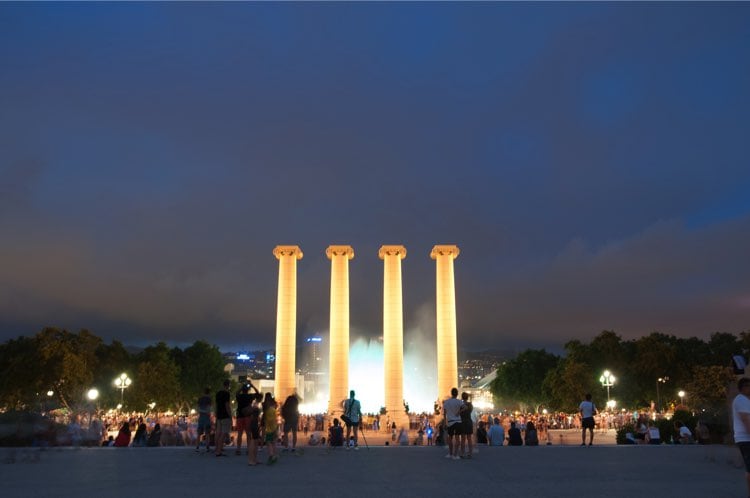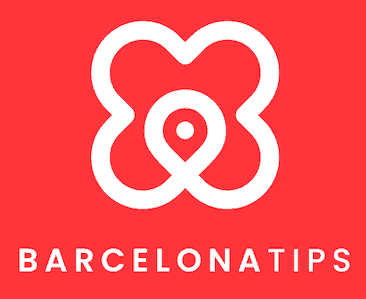The ‘Font Màgica’ fountain show at the Montjuïc is visited by as many as two and a half million tourists every year. The fountains were designed by Catalan architect Carles Buïgas, also the architect of the extraordinary lighting in the Sagrada Família, especially for the 1929 World’s Fair.
Be aware: The magical fountains are currently closed! (updated January 2024)
| The magical fountain | Tickets, opening hours & public transportation |
|---|---|
| Price | Free |
| Address | Plaça de Carles Buïgas 1 |
| Public transport/ metro | Metro: Espanya (L1 and L3) |
| Opening hours | Currently, the magic fountain is off |
Contents
- What is the Magic Fountain Show?
- Plan your visit to the magical fountains
- Practical information
- How do you get to the magical fountains?
- History of the Magic Fountains in a timeline
- Tradition
- Restaurants near the magic fountains
What is the Magic Fountain Show?
This spectacular water and light show with music is high on many people’s (and especially children’s) list of must-sees in Barcelona. The free show is absolutely impressive, although it has become touristy.
Fact: only recycled water is used for the popular water ballet where the water is pushed meters high into the air.
Plan your visit to the magical fountains
The shows take place several days a week in the evening and are at their best when it is well dark. Scroll down a bit for the exact days and times. A show lasts about 20 minutes and the music and show itself are always different. From classical to film scores. So you won’t see the exact same show every 20 minutes.
On Montjuïc, where the fountain stands, there is much more to do and the view of the city is really a must. So you can very well combine the show with a walk on the city hill, a visit to an exhibition at the CaixaForum or the art museum MNAC.
In summer, the terrace of the MNAC is open until midnight, for drinks and snacks. From that terrace you have a view of the show, but from a distance.

On Montjuïc you can also visit the Olympic Stadium or go to Poble Espanyol and if you are a nature lover, you can indulge in one of the gardens, did you know for example that there is a practical cactus garden? In short: plenty of choice, you can spend a whole day there!
Tip: If you have a ticket for the Hop on Hop off bus, take the red route to the fountains and plot your visit all the way!
If you prefer to shop beforehand, you can head to Las Arenas shopping center on Plaça d’Espanya. Take the elevator to the top for another great view of the city and to get some fresh air.
When to visit the magical fountains?
Shows take place Wednesday through Sunday or Thursday through Friday, depending on the time of year. The exact time of day also depends on the time of year. It is actually always busy, both in summer and winter, although of course during the peak season it is at its peak.
Furthermore, make sure you arrive well in advance to have a better chance of finding a good (seating) spot! There is plenty to see and do around the fountains, so you will certainly not be bored.
Practical information
To watch the Magic Fountain Show, you don’t have to pay an entrance fee, and you can watch the show from different spots. A nice option is the top floor of Las Arenas shopping mall, where you can get a super view. If you watch the show outside, don’t forget to bring snacks and drinks for a very special picnic. I think the fountain show is highly recommended for families. Kids will feast their eyes!
Opening hours
At Christmas and New Year’s Eve, there are special, extra shows, and at the end of September, on the day that Barcelona’s most enjoyable week of festivities, the fiestas of patron saint La Mercé, conclude, there is a spectacle combined with a dazzling fireworks show, called the piromusical.
The annual maintenance usually starts after Epiphany, on January 7 and lasts until the entire month of February, during which time there are no shows.
How do you get to the magical fountains?
With public transportation, you can get to Plaça d’Espanya in no time, but also by bike or even walking. Below are several possibilities:
Metro: Lines L1 (red) and L3 (green), Espanya stop. No matter which exit you take, you can’t miss it, there are escalators going up that will take you up to the fountains.
Bus: There are lots of buses going from Pl.Catalunya towards Pl.Espanya, for example, but the metro is still a must, it is much faster.
Hop on Hop off bus: The red route stops at Pl. Espanya and the MNAC.
Cab: By cab you will get there in no time and it is quite cheap, also at Pl. Espanya you can very easily take a cab back.
Bike: Did you rent an electric bike? Then you can go straight up the mountain towards the MNAC where you can park it (note, never against a pole or a tree, only in a bike rack). A regular bike is best parked on Pl. Espanya or take it up the escalators, Carola shows you in the video below.
Walking: From the center it’s a bit of a walk but it’s fine! There are several major roads leading to Pl.Espanya but you can also go via the Poble Sec neighborhood, bit of adventure and then use the route planner on your phone!
Cable car (telefèric de Montjuïc): With the cable car you can go up Montjuïc from the sea, it does not bring you to the fountains but you can walk it afterwards (in 15-20 minutes) and the surroundings are beautiful (views!).
Funicular de Montjuïc: You can also, just with your public transport ticket, from metro stop Paral.lel take the funicular up the mountain. This is a kind of little train that takes you to the top of the hill in two minutes, the stop is near that of the funicular and the walk to the fountains is about 15-20 minutes.

History of the Magic Fountains in a timeline
1929: People thought it only ambitious when Buïgas presented his plans for the fountains. Three thousand workers worked on it for a year and it was finished before the World’s Fair that took place in 1929.
1936-1939: During the Spanish Civil War and its aftermath, the fountains were severely damaged by numerous bombings.
1954-1955: During this period, the first real restoration took place, again under the direction of Buïgas.
1976: From this year on, the shows were accompanied by music, which is still the case today.
1992: During the opening ceremonies of the Olympic Games, a sizzling show is performed.
1993-1998: Due to lack of maintenance, the fountains close.
1998: In June of this year, they reopen after a thorough repair that follows Buïgas’ original constructions. To this day, the engineer’s original motors under the fountains are still in use and there are as many as seven million different combinations of light-music-color!
Tradition

Armed with a picnic basket and a bottle of cava, end the week while enjoying a beautiful fountain show, complete with spectacular lighting effects and music. For a long time, this was a beloved Sunday tradition among city residents.
Freddie Mercury’s Barcelona
A regular feature of the program is the song Barcelona, written by Freddie Mercury. The Queen frontman wrote the duet and performed it with Catalan opera singer Montserrat Cabellé on Oct. 8, 1988, during an open-air show at Montjuïc that drew 20,000 people. What many spectators probably did not know at the time is that the song was not sung live, but playbacked.
Later that year, the song was declared the anthem of the 1992 Olympic Games held in Barcelona. Mercury died of AIDS in 1991 and thus did not make it to the opening ceremony of the Games. The song was performed in the summer of 1992 by Caballé and the tenor José Carreras.
Besides Barcelona, the Magic Fountains also move other well-known (and slightly more modern) songs. The video below was made in the spring of 2017. Each show lasts about 20 minutes.
Restaurants near the magic fountains
The best thing to do is to sit somewhere with your own snacks and drinks during the show, but if you’re also going to be doing and seeing all sorts of things beforehand, that might be a less practical idea. Here are a few tips for when you get hungry and/or thirsty:
- At shopping center Las Arenas you can eat anything and everything from wok to paella, but don’t expect culinary delights. Handy to know: there are two large supermarkets in the shopping center, one regular and one organic.
- On the corner to the left of Las Arenas you will find the Buenas Migas, which is a good place for Italian-style dishes like focaccias and pasta salad, both hot and cold. They have good coffee, tea with all kinds of sweet treats and fresh juices, all from their own kitchen.
- On the Gran Vía that leads to Plaça d’Espanya, there are countless restaurants and bars, a terrace on every corner. Fancy just a (hot) sandwich or a simple salad? At SandwiChez you sit nice and quiet, the wifi works well, the coffee is good and it is not far from Pl.Espanya (address: Gran Vía de les Corts Catalanes 403, corner with c/Vilamarí which is on the Las Arenas side).
- The boulevard Avinguda Mistral, which also opens into Pl.Espanya and runs more or less parallel to the Gran Vía is dotted with terraces, bakeries and stores, quiet too, as there are large stretches where no or almost no cars drive.


